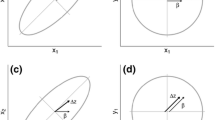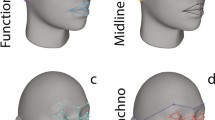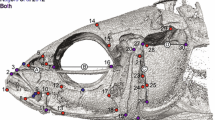Abstract
Theories of phenotypic integration have relied heavily on the concept of modularity in order to model the ways in which traits in an organism correlate and covary. Recent investigations suggest that, while some functional and developmental processes may be morphologically and ontogenetically localized, and thus modular in a developmental sense, there is a great deal of overlap among these influences on patterns of integration in the adult form. This can result in blurry boundaries between hypothesized modules constructed to test hypotheses about phenotypic integration. This investigation tests hypotheses about the contribution of pleiotropic quantitative trait loci (QTL) to phenotypic integration in the mouse mandible without using a priori categorical hypotheses about which traits constitute a module. We ask two main questions: (1) Are the effects of pleiotropic QTL localized to highly correlated traits or more spread out among traits than one might expect by chance? (2) Does the pattern of trait influence when all pleiotropic QTL are considered together deviate from what we might expect if QTL affect traits without regard for the correlations among traits? We find that a large proportion of pleiotropic QTL affect traits that are more highly correlated than we expect by chance with the remainder having effects that are distributed as if by chance. Furthermore, the overall distribution of the effects of pleiotropic QTL differs significantly from the null distribution of no association between pleiotropic effects on traits and correlations among traits. The main modular hypothesis used by earlier studies often does not predict the distribution of sets of traits sharing a common QTL. These results suggest that there is a clear tendency for pleiotropic effects of QTL to be localized but that the localization may be best thought of as occurring in a continuous space rather being clustered in discrete modules.


Similar content being viewed by others
References
Arnold, S. J., Burger, R., Hohenlohe, P. A., Ajie, B. C., & Jones, A. G. (2008). Understanding the evolution and stability of the G-matrix. Evolution, 62(10), 2451–2461.
Arnold, S. J., Pfrender, M. E., & Jones, A. G. (2001). The adaptive landscape as a conceptual bridge between micro- and macroevolution. Genetica, 112, 9–32.
Atchley, W. R. (1993). Genetic and developmental aspects of variability in the mammalian mandible. In J. Hanken & B. K. Hall (Eds.), The skull (pp. 207–247). Chicago: University of Chicago Press.
Atchley, W. R., Cowley, D. E., Vogl, C., & Mclellan, T. (1992). Evolutionary divergence, shape change, and genetic correlation structure in the rodent mandible. Systematic Biology, 41(2), 196–221.
Atchley, W. R., & Hall, B. K. (1991). A model for development and evolution of complex morphological structures. Biological Reviews of the Cambridge Philosophical Society, 66(2), 101–157.
Atchley, W. R., Plummer, A. A., & Riska, B. (1985). Genetics of mandible form in the mouse. Genetics, 111(3), 555–577.
Bailey, D. W. (1956). A comparison of genetic and environmental principal components of morphogenesis in mice. Growth, 20, 63–74.
Cheverud, J. M. (1982). Phenotypic, genetic, and environmental morphological integration in the cranium. Evolution, 36(3), 499–516.
Cheverud, J. M. (1984). Quantitative genetics and developmental constraints on evolution by selection. Journal of Theoretical Biology, 110(2), 155–171.
Cheverud, J. M. (1995). Morphological integration in the saddle-back tamarin (saguinus-fuscicollis) cranium. American Naturalist, 145(1), 63–89.
Cheverud, J. M. (1996a). Developmental integration and the evolution of pleiotropy. American Zoologist, 36(1), 44–50.
Cheverud, J. M. (1996b). Quantitative genetic analysis of cranial morphology in the cotton-top (saguinus oedipus) and saddle-back (S-fuscicollis) tamarins. Journal of Evolutionary Biology, 9(1), 5–42.
Cheverud, J. M. (2001a). The genetic architecture of pleiotropic relations and differential epistasis. In G. P. Wagner (Ed.), The character concept in evolutionary biology (pp. 411–434). San Diego: Academic Press.
Cheverud, J. M. (2001b). A simple correction for multiple comparisons in interval mapping genome scans. Heredity, 87, 52–58.
Cheverud, J. M., Hartman, S. E., Richtsmeier, J. T., & Atchley, W. R. (1991). A quantitative genetic-analysis of localized morphology in mandibles of inbred mice using finite-element scaling analysis. Journal of Craniofacial Genetics and Developmental Biology, 11(3), 122–137.
Cheverud, J. M., Routman, E. J., & Irschick, D. J. (1997). Pleiotropic effects of individual gene loci on mandibular morphology. Evolution, 51(6), 2006–2016.
Churchill, G. A., & Doerge, R. W. (1994). Empirical threshold values for quantitative trait mapping. Genetics, 138(3), 963–971.
Darvasi, A., & Soller, M. (1995). Advanced intercross lines, an experimental population for fine genetic-mapping. Genetics, 141(3), 1199–1207.
Ehrich, T. H., Vaughn, T. T., Koreishi, S., Linsey, R. B., Pletscher, L. S., & Cheverud, J. M. (2003). Pleiotropic effects on mandibular morphology I. developmental morphological integration and differential dominance. Journal of Experimental Zoology Part B-Molecular and Developmental Evolution, 296B(1), 58–79.
Estes, S., & Arnold, S. J. (2007). Resolving the paradox of stasis: Models with stabilizing selection explain evolutionary divergence on all timescales. American Naturalist, 169(2), 227–244.
Haley, C. S., & Knott, S. A. (1992). A simple regression method for mapping quantitative trait loci in line crosses using flanking markers. Heredity, 69, 315–324.
Hallgrimsson, B., & Lieberman, D. E. (2008). Mouse models and the evolutionary developmental biology of the skull. Integrative and Comparative Biology, 48, 373–384.
Hunley, K. L., Healey, M. E., & Long, J. C. (2009). The global pattern of gene identity variation reveals a history of long-range migrations, bottlenecks, and local mate exchange: Implications for biological race. American Journal of Physical Anthropology, 139(1), 35–46.
Jones, A. G., Arnold, S. J., & Burger, R. (2007). The mutation matrix and the evolution of evolvability. Evolution, 61(4), 727–745.
Klingenberg, C. P., Leamy, L. J., & Cheverud, J. M. (2004). Integration and modularity of quantitative trait locus effects on geometric shape in the mouse mandible. Genetics, 166(4), 1909–1921.
Klingenberg, C. P., Leamy, L. J., Routman, E. J., & Cheverud, J. M. (2001). Genetic architecture of mandible shape in mice: Effects of quantitative trait loci analyzed by geometric morphometrics. Genetics, 157(2), 785–802.
Knott, S. A., & Haley, C. S. (2000). Multitrait least squares for quantitative trait loci detection. Genetics, 156(2), 899–911.
Konigsberg, L. W. (2006). A post-neumann history of biological and genetic distance studies. In J. E. Buikstra (Ed.), Bioarchaeology: The contextual analysis of human remains (pp. 263–280). London: Academic Press.
Lande, R. (1980). The genetic covariance between characters maintained by pleiotropic mutations. Genetics, 94(1), 203–215.
Lande, R., & Arnold, S. J. (1983). The measurement of selection on correlated characters. Evolution, 37(6), 1210–1226.
Li, J., & Ji, L. (2005). Adjusting multiple testing in multilocus analyses using the eigenvalues of a correlation matrix. Heredity, 95, 221–227.
Mantel, N. (1967). The detection of disease clustering and a generalized regression approach. Cancer Research, 27, 209–220.
Mezey, J. G., Cheverud, J. M., & Wagner, G. P. (2000). Is the genotype-phenotype map modular?: A statistical approach using mouse quantitative trait loci data. Genetics, 156(1), 305–311.
Norgard, E. A., Jarvis, J. P., Roseman, C. C., Maxwell, T. J., Kenney-Hunt, J. P., Samocha, K. E., et al. (2009). Replication of long bone length QTL in the F9–F10 LG,SM advanced intercross. Mammalian Genome (in press).
Pavlicev, M., Kenney-Hunt, J. P., Norgard, E. A., Roseman, C. C., Wolf, J. B., & Cheverud, J. M. (2008). Genetic variation in pleiotropy: Differential epistasis as a source of variation in the allometric relationship between long bone lengths and body weight. Evolution, 62(1), 199–213.
Robertson, A. (1965). The interpretation of genotypic ratios in domestic animal populations. Animal Production, 7, 319–324.
Roff, D. A. (1997). Evolutionary quantitative genetics. New York, NY: Chapman and Hill.
Schluter, D. (1996). Adaptive radiation along genetic lines of least resistance. Evolution, 50, 1766–1774.
Steppan, S. J., Phillips, P. C., & Houle, D. (2002). Comparative quantitative genetics: Evolution of the G matrix. Trends in Ecology & Evolution, 17(7), 320–327.
Wagner, G. P., Pavlicev, M., & Cheverud, J. M. (2007). The road to modularity. Nature Reviews Genetics, 8(12), 921–931.
Whitlock, M. C., Phillips, P. C., & Fowler, K. (2002). Persistence of changes in the genetic covariance matrix after a bottleneck. Evolution, 50(10), 1968–1975.
Wolf, J. B., Pomp, D., Eisen, E. J., Cheverud, J. M., & Leamy, L. J. (2006). The contribution of epistatic pleiotropy to the genetic architecture of covariation among polygenic traits in mice. Evolution and Development, 8(5), 468–476.
Acknowledgements
We thank Steve Leigh, Laura Shackelford, Joe Jarvis, Rebecca Rogers Ackermann, Lyle Konigsberg, Benedikt Hallgrimsson, and the anonymous reviewers for their thoughtful insights and discussion. The lab assistance provided by Victor Ekuta and Michelle Eisenberg was a great help. We also thank all of the members of the Genomics of Cranial Morphology Consortium including Joan Richtsmeier, Jeff Rogers, Alan Walker and Ken Weiss for their support. Funding for this study was provided by NIH grant RR015116, NSF grant BCS 0725068, and The Center for Advanced Studies at the University of Illinois.
Author information
Authors and Affiliations
Corresponding author
Additional information
An erratum to this article can be found at http://dx.doi.org/10.1007/s11692-009-9073-8
Rights and permissions
About this article
Cite this article
Roseman, C.C., Kenny-Hunt, J.P. & Cheverud, J.M. Phenotypic Integration Without Modularity: Testing Hypotheses About the Distribution of Pleiotropic Quantitative Trait Loci in a Continuous Space. Evol Biol 36, 282–291 (2009). https://doi.org/10.1007/s11692-009-9067-6
Received:
Accepted:
Published:
Issue Date:
DOI: https://doi.org/10.1007/s11692-009-9067-6




